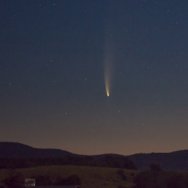
Comets Blog
This month’s ALPO Comet News will be another short one. Again, other commitments are vying for my time, and only four comets are expected to be brighter than magnitude 12 this month.
Northern hemisphere observers will be able to watch two fading comets, 13P/Olbers fade from 7th to 8th magnitude and C/2023 V4 (Camarasa-Duszanowicz) from 11th to 13th. Southern hemisphere observers will be able to observe 12P/Pons-Brooks fade from 9th to 10th magnitude. Southern observers will also be able to catch C/2023 A3 (Tsuchinshan-ATLAS) brighten from 8th to 7th magnitude before losing it to the glare of twilight around mid-month.
Last month, the ALPO Comets Section received 247 images and 164 magnitude estimates of 44 comets: 12P/Pons-Brooks, 13P/Olbers, 21P/Giacobini-Zinner, 29P/Schwassmann-Wachmann, 32P/Comas Sola, 37P/Forbes, 62P/Tsuchinshan, 65P/Gunn, 89P/Russell, 125P/Spacewatch, 130P/McNaught-Hughes, 144P/Kushida, 146P/Shoemaker-LINEAR, 154P/Brewington, 208P/McMillan, 227P/Catalina-LINEAR, 236P/LINEAR, 251P/LINEAR, 253P/PANSTARRS, 299P/Catalina-PANSTARRS, 468P/Siding Spring, C/2017 K2 (PANSTARRS), C/2019 O3 (Palomar), C/2019 T4 (ATLAS), C/2019 U5 (PANSTARRS), C/2020 K1 (PANSTARRS), C/2020 V2 (ZTF), C/2021 G2 (ATLAS), C/2021 S3 (PANSTARRS), C/2021 X1 (Maury-Attard), C/2022 E2 (ATLAS), C/2022 L2 (ATLAS), C/2022 N2 (PANSTARRS), C/2022 U1 (Leonard), C/2023 A3 (Tsuchinshan-ATLAS), C/2023 C2 (ATLAS), C/2023 V4 (Camarasa-Duszanowicz), C/2023 X1 (Leonard), C/2024 A2 (ATLAS), C/2024 C4 (ATLAS), C/2024 E1 (Wierzchos), C/2024 F2 (PANSTARRS), C/2024 G1 (Wierzchos), C/2024 G3 (ATLAS), and C/2024 J1 (Wierzchos).
A big thanks to our recent contributors: Dan Bartlett, José J. Chambó, Dan Crowson, Michel Deconinck, Jose Guilherme de Souza Aguiar, Juan Jose Gonzalez Suarez, Christian Harder, Eliot Herman, Rik Hill, Michael Jäger, John Maikner, Gianluca Masi, Michael Mattiazzo, Martin Mobberley, Mike Olason, Andrew Pearce, Uwe Pilz, Chris Schur, Greg T. Shanos, Tenho Tuomi, and Christopher Wyatt.
The monthly ALPO Comet News PDF can be found here. A shorter version of this report is posted on a dedicated Cloudy Nights forum. All are encouraged to join the discussion over at Cloudy Nights.
Comets News Headlines
Comet's impact triggered downfall of ancient Hopewell?
2/1/2022
The rapid decline of the Hopewell culture about 1,500 years ago might be explained by falling debris from a near-Earth comet that created a devastating explosion over North America, laying waste to forests and Native American villages alike. Researchers found evidence of a cosmic airburst at 11 Hopewell archaeological sites in three states stretching across the Ohio River Valley.
Read More
New comet C/2021 O3 Might Brighten in May 2022
1/20/2022
A comet discovered last July is approaching the inner solar system and might reach binocular visibility (at least) by late April and early May 2022. It’s designated C/2021 O3 (PanSTARRS) and appears to be “new” to the inner solar system, a first-time visitor. If it survives its April 2022 passage near our star, the comet might become visible to amateur stargazers armed with binoculars in May. At that time, it’ll be in front of the constellation Perseus the Hero, close to the northwestern horizon after sunset.
Read More
Comets’ heads can be green, but never their tails
12/20/2021
Comets often go through a colorful transformation as they cross the sky, with many comets' heads turning a brilliant green color that gets brighter as they approach the Sun. But strangely, this green shade disappears before it reaches the one or two tails trailing behind the it. After almost a century we have a possible answer to explain this behavior.
Read More
Event Calendar
Oct 12, 2024
Comet C/2023 A3 (Tsuchinshan-ATLAS) reaches perigee
Nov 29, 2024
Comet 333P/LINEAR reaches perihelion
